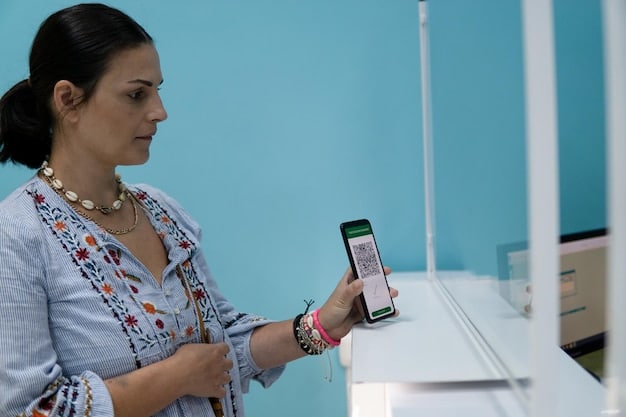Mobile Accessibility 2025: WCAG Compliance for US E-commerce

Ensuring mobile accessibility for e-commerce sites in the US by 2025 requires strict adherence to WCAG guidelines, which focus on making web content more accessible to people with disabilities, ultimately improving user experience and avoiding potential legal issues.
Is your e-commerce site ready to meet the mobile accessibility requirements for US users in 2025? With the increasing reliance on mobile devices for online shopping, ensuring your site is compliant with WCAG guidelines is not just ethical, but crucial for reaching a wider audience and avoiding potential legal repercussions.
Understanding Mobile Accessibility and WCAG
In today’s digital landscape, mobile devices have become the primary tool for accessing the internet for many users. Therefore, mobile accessibility which deals with designing websites and applications that are usable for people with disabilities on mobile devices, needs to be a priority for e-commerce businesses.
WCAG (Web Content Accessibility Guidelines) are a set of international standards developed by the World Wide Web Consortium (W3C) to make web content more accessible to people with disabilities. These guidelines are organized under four principles: Perceivable, Operable, Understandable, and Robust (POUR).
The Four Principles of WCAG
The WCAG guidelines are structured around four main principles, each encompassing various guidelines and success criteria. Ensuring your e-commerce site adheres to these principles is key to achieving mobile accessibility.
- Perceivable: Information and user interface components must be presentable to users in ways they can perceive. This includes providing text alternatives for non-text content, captions for multimedia, and ensuring content is adaptable and distinguishable.
- Operable: User interface components and navigation must be operable. This means making all functionality available from a keyboard, providing enough time for users to read and use content, and avoiding content that could cause seizures.
- Understandable: Information and the operation of the user interface must be understandable. This involves making text readable and understandable, ensuring content appears and operates in predictable ways, and helping users avoid and correct mistakes.
- Robust: Content must be robust enough that it can be interpreted reliably by a wide variety of user agents, including assistive technologies. This includes ensuring compatibility with current and future user agents.
By following the POUR principles, e-commerce sites can create a more inclusive and user-friendly experience for all mobile users, regardless of their abilities.
Understanding the fundamentals of mobile accessibility and WCAG is the first key step in ensuring your e-commerce site complies with accessibility standards, creating a better shopping experience for every user.
Why Mobile Accessibility Matters for E-commerce in the US
Ignoring mobile accessibility in the US e-commerce market can lead to significant drawbacks. Not only does it limit your customer base, but it also opens you up to legal risks and damages your brand reputation.

Here’s why mobile accessibility should be a top priority for your e-commerce business:
- Legal Compliance: The Americans with Disabilities Act (ADA) requires businesses to provide equal access to goods and services. While the ADA doesn’t explicitly mention websites, courts have interpreted it to include online platforms. Non-compliance can lead to lawsuits and hefty fines.
- Expanded Market Reach: Over 61 million adults in the US have a disability. By making your e-commerce site accessible, you tap into a significant market segment, increasing your potential customer base and sales.
- Improved User Experience: Accessibility features often benefit all users, not just those with disabilities. Clear navigation, readable fonts, and properly labeled forms enhance the overall user experience, leading to increased customer satisfaction and loyalty.
- Enhanced SEO: Search engines like Google favor websites that are accessible and user-friendly. Implementing accessibility best practices can improve your search engine rankings and drive more organic traffic to your site.
By prioritizing mobile accessibility, e-commerce businesses can avoid legal trouble, expand their market reach, enhance user experience, and improve SEO, leading to a more successful and inclusive online presence.
Therefore, investing in mobile accessibility in the US is not merely an ethical imperative; it’s a strategic business move that drives growth, enhances brand reputation, and ensures long-term success.
Key WCAG Guidelines for Mobile E-commerce Accessibility
Implementing WCAG guidelines effectively ensures that your mobile e-commerce site is accessible to a wider audience. Each guideline addresses specific aspects of website design and functionality.
Here are some key WCAG guidelines to focus on for mobile e-commerce accessibility:
Text Alternatives
Provide text alternatives for any non-text content so that it can be changed into other forms people need, such as large print, braille, speech, symbols, or simpler language.
Adaptable Content
Creating content that can be presented in different ways (for example simpler layout) without losing information or structure. This is particularly important for mobile devices with varying screen sizes and orientations.
Time-Based Media
Provide alternatives for time-based media. This includes captions and audio descriptions for videos, ensuring that users who cannot see or hear the content can still understand it.
Navigable Structure
Make it easy for users to navigate, find content, and determine where they are. A clear and consistent navigation structure is crucial, especially on mobile devices with limited screen space.
Understanding and implementing these essential WCAG guidelines is crucial for creating a mobile e-commerce site that is inclusive, user-friendly, and compliant with accessibility standards.
By focusing on these guidelines, e-commerce sites can significantly improve the shopping experience for all users, regardless of their abilities.
Practical Steps to Ensure WCAG Compliance on Mobile
Achieving WCAG compliance for your mobile e-commerce site requires a mix of design best practices, coding techniques, and rigorous testing. Implementing these steps will ensure your site is inclusive for all users.

Here are some practical steps to ensure WCAG compliance on mobile:
- Conduct an Accessibility Audit: Use automated tools and manual testing to identify accessibility issues on your site. Tools like WAVE and Axe can help you find common problems, but manual testing with assistive technologies like screen readers is also essential.
- Optimize for Keyboard Navigation: Ensure that all interactive elements on your site are accessible via keyboard. This is crucial for users who cannot use a mouse or touchscreen.
- Use Semantic HTML: Use HTML elements semantically to provide structure and meaning to your content. This helps assistive technologies understand and interpret the content correctly.
Testing with Assistive Technologies
One of the most effective ways to ensure WCAG compliance is to test your e-commerce site with assistive technologies like screen readers, magnifiers, and speech recognition software.
Testing helps identify usability issues that may not be apparent through automated testing or visual inspection. By simulating the experience of users with disabilities, you can gain invaluable insights into how to improve your site’s accessibility.
By taking these practical steps and committing to ongoing testing and improvement, you can ensure that your mobile e-commerce site meets WCAG standards and provides a seamless shopping experience for all users.
Regular audits and testing with assistive technologies are key when developing mobile e-commerce sites for accessibility.
Tools and Resources for Mobile Accessibility
Several tools and resources are available to help e-commerce businesses assess and improve mobile accessibility. Using a combination of automated tools, browser extensions, and resources can streamline the process of achieving WCAG compliance.
Here are some useful tools and resources for mobile accessibility
- WAVE (Web Accessibility Evaluation Tool): A free web accessibility evaluation tool that provides visual feedback about the accessibility of your web content.
- Axe (Accessibility Engine): A browser extension and command-line tool for automated accessibility testing. Axe is known for its accuracy and detailed reporting.
- Lighthouse: An open-source, automated tool for improving the quality of web pages. It has audits for accessibility, performance, SEO, and more.
- WebAIM (Web Accessibility In Mind): Provides comprehensive resources on web accessibility, including articles, tutorials, and evaluation tools.
Browser Extensions
Browser extensions like Axe and WAVE can be particularly useful for identifying accessibility issues directly within your web browser.
These tools allow developers and designers to quickly scan web pages for common accessibility errors and receive detailed guidance on how to fix them.
By leveraging these tools and resources, e-commerce businesses can streamline the process of assessing and improving mobile accessibility, ensuring their sites meet WCAG standards and provide a seamless shopping experience for all users.
From selecting testing tools to finding the right resources, make sure you are up-to-date with the latest information in mobile accessibility.
Legal Implications and the Future of Mobile Accessibility
Understanding the legal implications of mobile accessibility and staying informed about future trends is crucial for e-commerce businesses. Non-compliance can lead to legal challenges, while proactive adaptation ensures long-term success.
Here’s a look at the legal implications and the future of mobile accessibility:
- The Americans with Disabilities Act (ADA): While the ADA doesn’t explicitly mention websites, courts have consistently ruled that it applies to online platforms, including e-commerce sites. Lawsuits related to website accessibility are on the rise, making compliance essential.
- WCAG as the Legal Standard: Courts often refer to WCAG as the standard for determining website accessibility. Following WCAG guidelines provides a strong defense against potential legal challenges.
- Evolving Accessibility Standards: WCAG is constantly evolving to address new technologies and user needs. Staying up-to-date with the latest guidelines is crucial for maintaining compliance.
The Future of Mobile Accessibility
The future of mobile accessibility is likely to be shaped by several key trends, including advancements in assistive technologies, the increasing use of artificial intelligence (AI), and a greater emphasis on inclusive design practices.
As technology continues to advance, new tools and techniques will emerge to make web content more accessible and user-friendly. E-commerce businesses that embrace these advancements will be well-positioned to meet the evolving needs of their customers and stay ahead of the competition.
By understanding the legal implications and staying informed about future trends, e-commerce businesses can ensure that their mobile sites remain accessible and compliant, providing a seamless shopping experience for all users.
The legal implications are real around mobile accessibility, so take time to stay up-to-date on the latest in accessibility standards.
| Key Aspect | Brief Description |
|---|---|
| ♿ WCAG Compliance | Adhering to WCAG guidelines ensures accessibility and inclusivity. |
| 📱 Mobile Optimization | Ensuring sites are usable across various mobile devices. |
| 🧑⚖️ Legal Standards | Compliance with ADA, emphasizing digital accessibility. |
| 🛠️ Accessibility Tools | Using tools like WAVE and Axe for auditing accessibility. |
Frequently Asked Questions
▼
WCAG (Web Content Accessibility Guidelines) are international standards for making web content accessible to people with disabilities. They are crucial for ensuring that everyone can use and understand online content, promoting inclusivity and compliance with accessibility laws.
▼
Mobile accessibility expands your market reach by including users with disabilities, improves overall user experience, enhances SEO by signaling user-friendliness to search engines, and ensures legal compliance, reducing the risk of lawsuits.
▼
Commonaccessibility mistakes include missing alternative text for images, poor keyboard navigation, insufficient color contrast, lack of captions for videos, and non-semantic HTML structure, all of which create barriers for users with disabilities.
▼
You can test your site using automated tools like WAVE and Axe, conducting manual testing with assistive technologies like screen readers, and involving users with disabilities in usability testing to identify and address accessibility issues effectively.
▼
The future includes advancements in assistive technologies, increased use of AI for automated accessibility improvements, and a greater emphasis on inclusive design practices, aiming for seamless and personalized accessible experiences for all users.
Conclusion
As we look ahead to 2025, ensuring mobile accessibility for e-commerce sites in the US is not just a matter of compliance, but a strategic imperative. By embracing WCAG guidelines, businesses can create inclusive, user-friendly experiences that expand their market reach, enhance their brand reputation, and ensure long-term success. Prioritizing accessibility is key to staying competitive in an increasingly diverse and digitally-driven marketplace.





